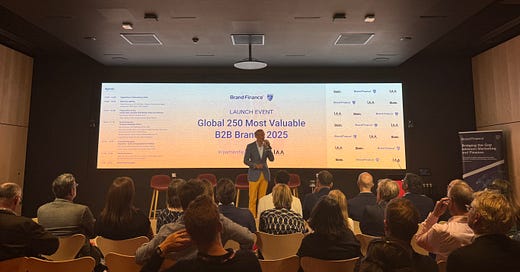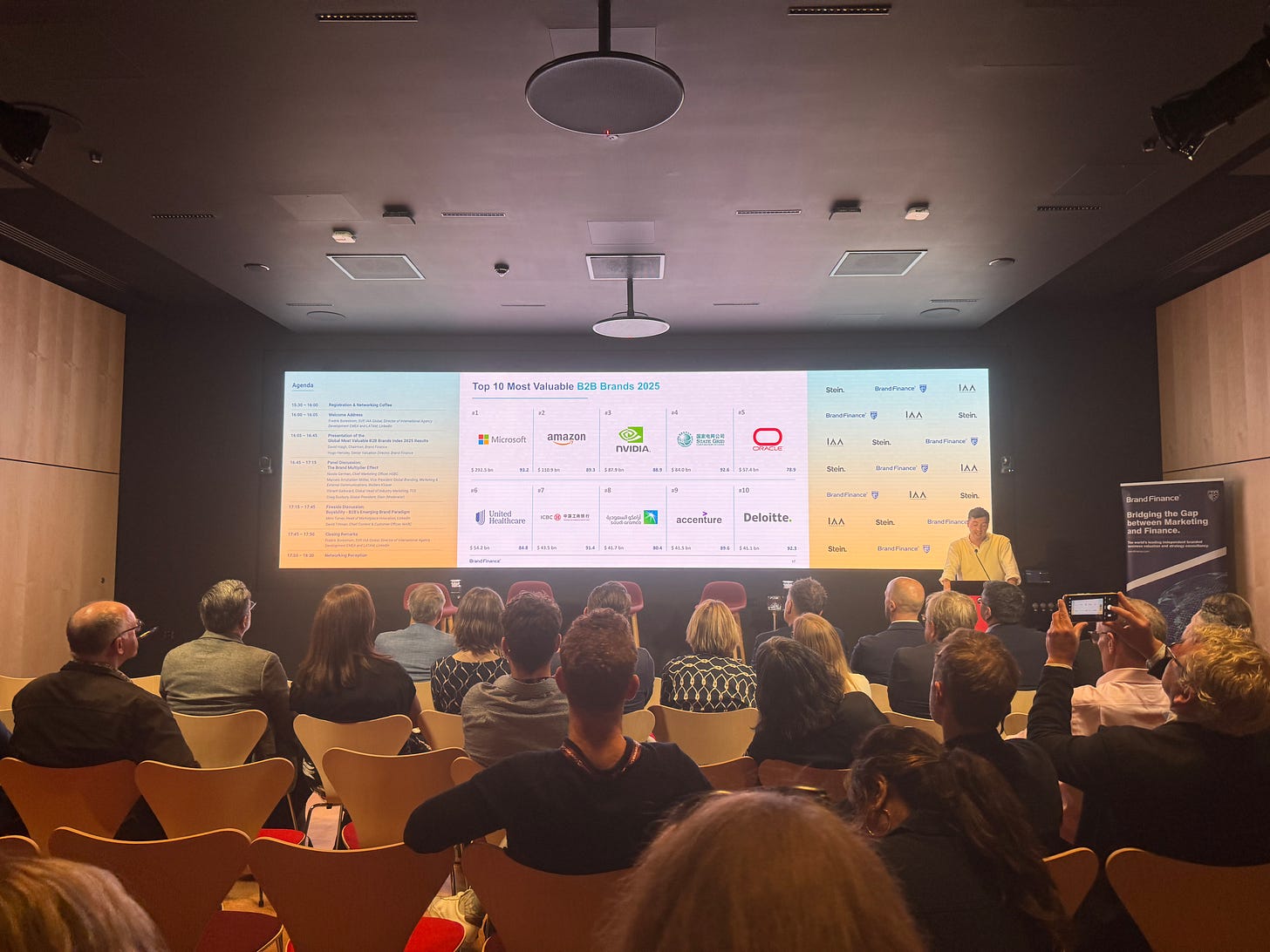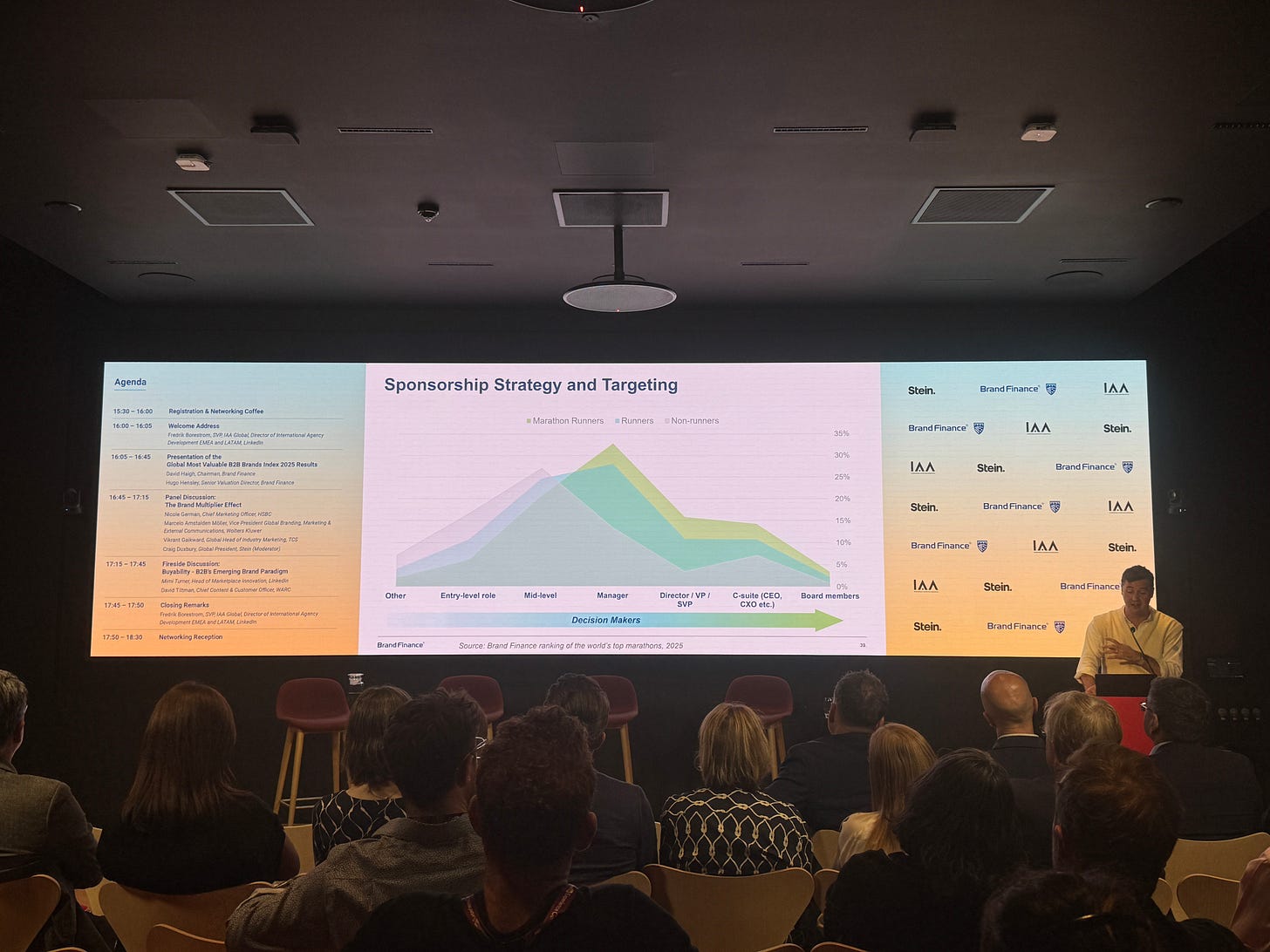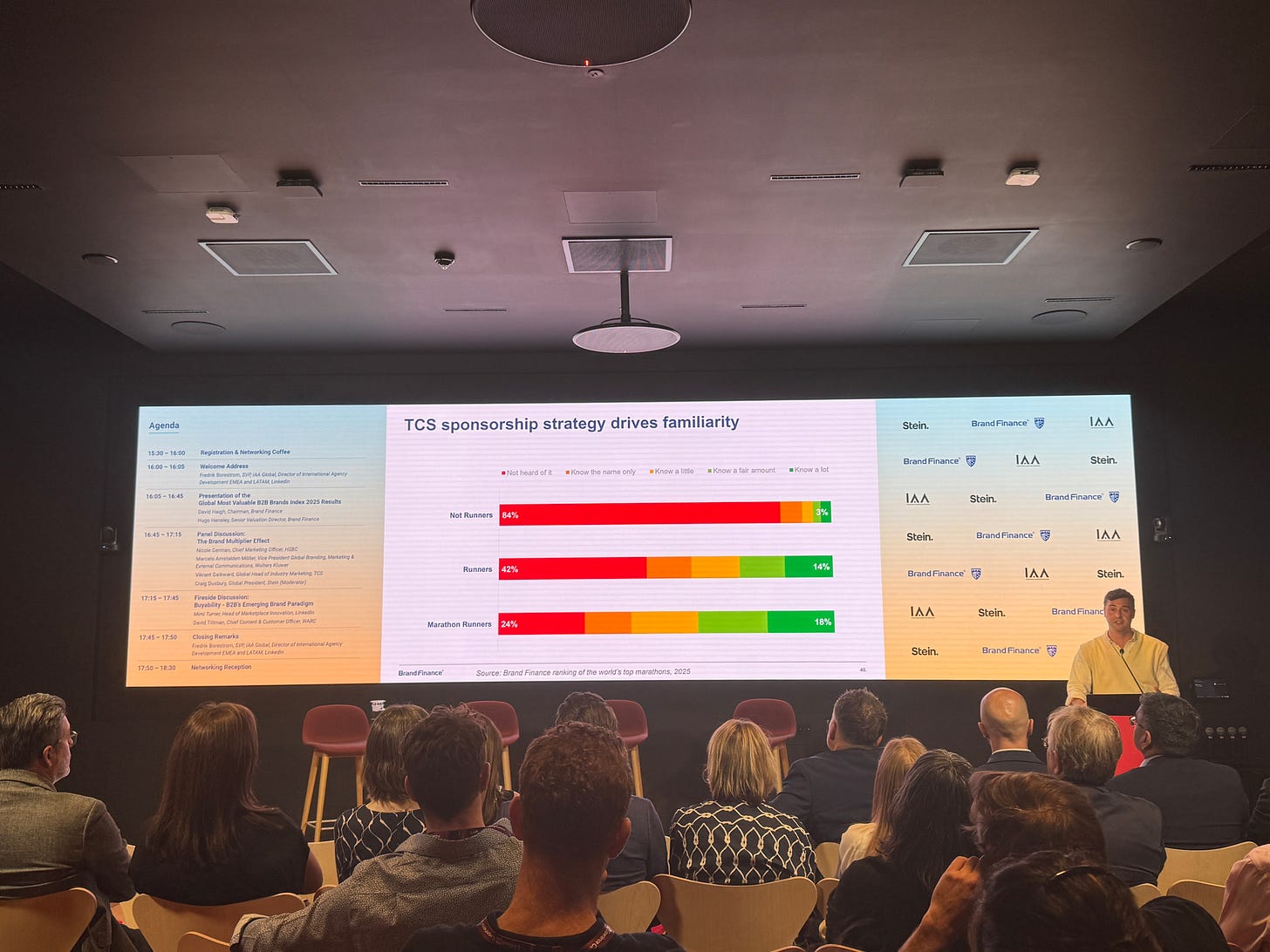Why All the World’s Most Valuable B2B Brands Are Using Sponsorship?
Insights and highlights from the Brand Finance B2B Brands 2025 Index launch at LinkedIn HQ, where experts shared how sponsorship is shaping the future of B2B marketing globally
Haven't subscribed yet? Join our community of sports enthusiasts eager to broaden their understanding of global sports. Whether you're a student, professional, or business owner, our newsletter provides invaluable insights into the sports industry.
Last week, I was invited to the LinkedIn HQ in London for the launch of the Brand Finance Global Most Valuable B2B Brands Index 2025. It was held at their new Experience Centre – a really cool space, and brought together people from branding, marketing, and finance to talk about what’s driving B2B brand value today.
We heard from some great speakers, looked at new trends, and got some useful insights on how brands can grow in today’s B2B world. As someone who works in the sports business and is especially passionate about the commercial side of sport, I was really interested in how sponsorship came up as a major driver of brand growth. So here are five takeaways that stood out to me:
1. The Most Valuable B2B Brands All Use Sponsorship
Let’s start with a simple fact: every single one of the top 10 most valuable B2B brands in the world — including Microsoft, Amazon, Oracle, Saudi Aramco, Accenture, Deloitte, and others — are actively investing in sponsorships. And they’re not doing it just for fun.
B2B marketing is a long game. Sales cycles are slow. Decisions are made by committees. So when the time finally comes to make a choice, the brand that’s top-of-mind is often the one that ends up top-of-list. That’s where sponsorship comes in.
Unlike traditional B2B marketing, which often feels dry or transactional, sponsorship shows up in places where people are already emotionally engaged — like sports, music, or major community events. These are environments where their message doesn’t compete with a dozen other ads. Instead, it becomes part of an experience people care about.
When a brand is linked to something meaningful, it helps people remember it. And when they’re remembered, it’s more likely to be considered and ultimately chosen, which is the philosophy of all these brands.
2. The Industries Leading the Way (And Why That Matters)
Some industries have embraced sponsorship faster than others, and it’s no surprise that they’re also leading in brand value. Banking, internet/software, engineering, oil & gas, and commercial services are at the top of the list. Together, these sectors represent nearly 40% of all B2B brand value globally.
In the past three years alone, these industries have been involved in over 5,000 sponsorship deals across sports, entertainment, and media. That’s a clear signal: sponsorship isn’t just a trend for them, but it’s a strategy.
Other sectors like healthcare, semiconductors, telecom, and logistics are starting to catch up. But no matter what industry you are in, the underlying truth remains the same — your buyers are humans first. And humans respond to emotion, community, and stories.
Sponsorship is one of the few marketing tools that lets you connect on all three levels. It gives you a chance to show what your brand stands for — not just what it sells.
3. Banking’s Case Study: How a Conservative Industry Became a Brand Storytelling Powerhouse?
In the financial services category, Banking might not seem like the most exciting sector when you think of sponsorship, but that’s exactly why it’s such an interesting case study. Banks have traditionally been seen as conservative and cautious. But now, many of them are using sponsorships to reshape their image and build trust with business customers for years.
One key insight from the Brand Finance report is that trust is the second most important factor in B2B brand perception. And trust is hard to earn with just ads or email campaigns.
When a bank sponsors a major event — whether it’s a global sports tournament or a local business summit — it’s doing more than buying space and creating awareness. It’s making a statement. It’s saying, “We’re present, we’re relevant, and we’re part of your world.” No better way of engagement.
Good sponsorships can help banks show they understand their clients’ industries, that they’re here to help businesses grow, and that they’re transparent about how they operate. Plus, sponsorships allow banks to create great experiences through hospitality, digital activations, and content (like athlete-led campaigns) that actually resonate.
And the bonus? Many of these sponsorships also appeal to the bank’s retail (B2C) customers. A well-executed sponsorship can speak to both audiences at once, which is pretty powerful.
4. It’s Not Just Broad Reach — It’s Smart, Targeted Reach
One concern B2B marketers often have is whether sponsorships can actually reach the right people, especially decision-makers. The good news? They absolutely can.
Take the example of TCS (Tata Consultancy Services) and its marathon sponsorships. At first glance, a tech company sponsoring marathons might seem like a mismatch. But dig a little deeper, and it’s a masterclass in brand strategy.
TCS found that their marathon sponsorships led to:
84% brand recognition among runners
50% brand recall among IT decision-makers
A 40% increase in brand consideration
They were also able to improve how people perceived their brand, with boosts in trustworthiness, innovation, and community involvement.
For a company whose services are mostly behind the scenes, sponsorships gave TCS a visible, human touch. They created meaningful moments by getting clients and employees involved — over 4,000 clients and 8,000 employees ran in marathons last year! These marathon events have raised $49 million for charity and generated a $2.5 billion economic impact in host cities.
What’s more, TCS turned these events into storytelling platforms. Through content, social media, and community engagement, they showed who they are, what they value, and how they make an impact — all while supporting causes like health, wellness, and charity.
It was a great reminder that sometimes, the most meaningful brand interactions happen outside the boardroom. For a company like TCS, whose services are largely invisible (think backend IT systems), sponsorship helps make the brand feel real, relatable, and human.
5. The Emotional Edge: Why This Matters for the Future?
Let’s wrap it up with something important that often gets overlooked in B2B: emotion.
In B2B, we spend so much time talking about features, performance, and ROI. But at the end of the day, even the most logical decision-makers are influenced by feelings. They want to work with brands they trust, partners that share their values, and businesses that make them feel something.
The presenter put it best: Emotional connection drives brand value. Sponsorship gives you a way to create that connection, to move beyond the functional and tap into something deeper.
The global picture tells us something interesting:
80% of commercial services B2B brand value comes from U.S. firms
91% of Chinese B2B brand value is earned within China
European brands are using sponsorship to spotlight their strengths in engineering, sustainability, and innovation
What this shows is that sponsorship isn’t just about visibility. It’s about cultural relevance, market leadership, and relevant storytelling. It's about showing the world what your brand believes in and not just what it sells.
Final Thought: Sponsorship as a Catalyst for Shared Growth
More and more, we’re seeing B2B companies investing in sport not only to reach their audiences but to actively support the ecosystems that matter to them and their stakeholders. It’s a shift from storytelling to story sharing.
A great example is Allianz’s landmark £100 million partnership with England Rugby. This deal goes far beyond naming Twickenham the “Allianz Stadium.” It includes substantial investment across multiple fronts — from strengthening the elite men’s and women’s teams, to launching the Allianz Future Fund, which will offer community rugby clubs access to financial support for local development. It will also fund grassroots initiatives, improve match-day experiences, and support community outreach that makes rugby more inclusive and accessible nationwide.
With this, Allianz isn’t just placing their brand in front of fans — they’re helping to secure the long-term sustainability and inclusivity of the sport. They’re aligning their values with the community’s values, which helps them earn genuine affinity and emotional trust.
Check out and read the full report here - CLICK
Some housekeeping stuff
If you can’t find the newsletter, check your Spam folder or Promotions tab, and move this email to your primary inbox. Make sure to mark this email address as ‘not spam’.
Today’s recommended podcast…
At The SPOT 2025 event in Lausanne, thought leaders and innovators came together to explore how sport is evolving in today’s rapidly changing media landscape. The podcast, moderated by
The discussion is on engaging diverse stakeholders through a shift to stakeholder capitalism and the importance of crafting authentic, relevant stories that resonate with Gen Z and Gen Alpha, who have shorter interest spans but not necessarily shorter attention spans.
The episode highlights how sports can build stronger fan connections by balancing exciting, fast-paced core products with innovative content strategies tailored to different platforms. Ultimately, the podcast stresses the need for sports to embrace new community-driven and media approaches to stay culturally relevant and sustainable in a competitive, fragmented attention economy.








